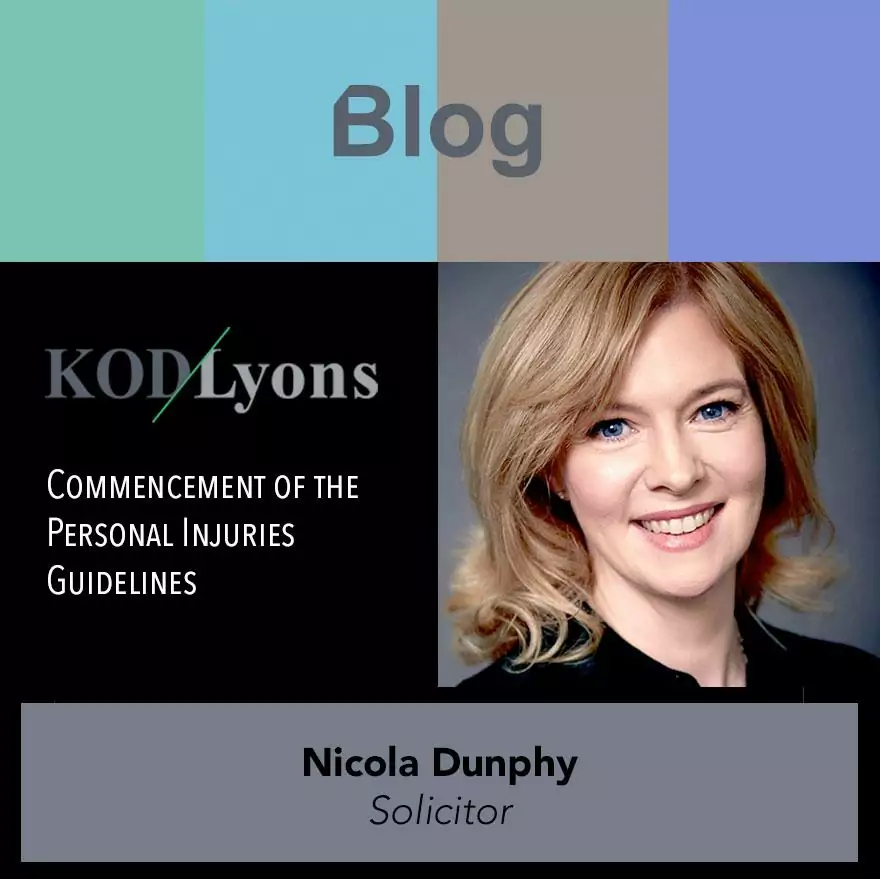Jill Valentine & Nicola Dunphy from the Personal Injuries Team analyse the recent introduction of the Personal Injuries Guidelines and its impact on the area of personal injuries litigation.
Introduction:
The Personal Injuries Guidelines came into effect on Saturday, 24th April 2021. This is a significant development in the area of Personal Injuries Litigation. The Guidelines have the aim of reducing and bringing consistency to the widely varying monetary awards of damages for pain and suffering in respect of relatively comparable injuries. The Guidelines replace the Book of Quantum which has been in force since 2004.
The Guidelines apply to:
Proceedings that were in being before the 24th April 2021 will continue to have regard to the Book of Quantum. Where proceedings issue after the 24th April 2021, the new Guidelines will apply unless an Assessment (under S.20 of the Personal Injuries Assessment Board Act 2003) issued before that date and that assessment was not accepted, then reference will be to the Book of Quantum.
General Principles:
As with the Book of Quantum any award must be fair and reasonable to both the claimant and the defendant(s). Awards must be proportionate to 1) the individual case and injuries sustained and 2) awards of damages commonly made in cases involving injuries of a greater or lesser magnitude. The aim is to achieve better consistency in awards, taking into account the individual features of each claim.
Use of the Guidelines:
At the conclusion of the trial the Judge should request each party to identify the dominant injury sustained and the damages bracket in the Guidelines which most closely represents injuries described. While the Court retains its independence and discretion in the awarding of damages, the Judge must have regard to the new Guidelines and if they depart from them, there should be details in the judgement as to what warranted the departure. It is worth noting that the Personal Injuries Assessment Board (“PIAB”) will also use the guidelines to assess claims.
Multiple Injuries:
Of particular difficulty is how the Court is to ensure that a claimant is not overcompensated where multiple injuries are sustained, as each injury is valued separately in the Guidelines. To overcome this issue, a Judge must identify the most significant injury and its bracket of damages within the Guidelines. The Judge must then uplift the value to ensure the claimant is justly compensated for the additional pain and suffering of the lesser injuries. This analysis should result in an award that is proportionate and fair to all parties.
Pre-existing Conditions:
The Guidelines provide that where a claimant has pre-existing complaints that have been aggravated by an incident/ accident, the court should have regard only to how the condition has been exacerbated. It is very likely that this direction will lead to an increased focus on examining doctors’ diagnosis and prognosis in such cases.
Injuries not specified in the Guidelines:
While the new Guidelines are comprehensive, there will be occasions where the claimant has suffered injuries not specified within them. In these instances, the Judge must have reference to Guidelines for equally significant injuries to ensure that the award made will be fair, just and proportionate within the scheme.
Heads of Injury:
There are 12 heads of injury included in the Guidelines, which are then measured as minor, moderate, severe/ serious and most severe:
- Injuries resulting in foreshortened life expectancy
- Injuries involving paralysis
- Head Injuries
- Psychiatric Damage
- Injuries affecting senses
- Injuries to Internal Organs
- Orthopaedic Injuries
- Chronic Pain
- Facial Injuries
- Non-Facial scarring and burns
- Damage to hair
- Dermatitis and other skin conditions
Considerations affecting the level of the award may include the following:
- Age;
- Scarring;
- Nature, severity and duration of pain;
- Nature, extent and duration of all treatment required e.g. surgery, physiotherapy, medication;
- Presence or risk of degenerative changes;
- Limitation of movement or instability in relevant joint;
- Interference with quality of life and leisure activities;
- Impact on social and domestic life;
- Impact on work;
- Extent of scarring;
- Psychological sequelae
Psychiatric Injuries:
Previously PIAB would not assess injuries of a psychiatric nature, they would issue an Authorisation to allow the claim to proceed to the courts. However, they can now be assessed under the new Guidelines. The Guidelines state that in the absence of physical injury, recovery is permitted only in respect of recognisable psychiatric injury: upset, distress, grief, disappointment and humiliation, do not attract compensation. Psychiatric damage has been divided into two categories 1) Psychiatric damage generally and 2) Post-Traumatic Stress Disorder (PTSD). To meet this threshold, it is likely that any claim of psychiatric damage/ PTSD will have to be backed by an expert opinion.
Guidelines v Book of Quantum:
The main difference between the Book of Quantum and the new Guidelines is the reduction in damages to be awarded, most significantly in relation to cases involving soft tissue injuries and other minor injuries. This reduction will be up to 50% in some instances. For example, the Book of Quantum provided that general damages in respect of a moderate neck injury (no more than five years) should be awarded €20,400 – €30,200. In comparison, the Guidelines provide that general damages in respect of a moderate neck injury, (usually less than five years) should be awarded €12,000 – €23,000. Also, as above, there is the inclusion of awards for psychiatric damages and skin conditions. We will have to wait to see how these are approached by the courts.
Conclusion:
The aim of these Guidelines is to create more consistency in the award of damages for comparable injuries. To help to achieve this end, there is no overlap between the brackets for the injuries, this could result in further debate as to which bracket the injury falls into. Undoubtedly to fix an injury to a particular bracket there will be more rigorous medical reporting to pigeonhole the injury to the bracket. Overall, it appears the Guidelines are likely to affect minor/ moderate injuries in the District and Circuit Court more so than the severe injuries associated with High Court litigation. It is worth noting that there were 87 in favour of the new Guidelines and 63 votes against, so at the outset there may be conflicting views as to their adequacy in any given case. With the Book of Quantum we saw a situation where the Book was not frequently referenced either by Courts or practitioners. Whilst the Guidelines are of a binding nature, in that the Court must have regard to the Guidelines, the Court may depart from the Guidelines, upon giving reasons for such a departure. Whether that exception open to the Court will become the norm remains to be seen. In reality for the time being there is going to be a two tier pre/ post Guidelines award system. The downward reduction of awards in personal injuries matters is not likely to be felt for a further 12 months in the Courts however we are starting to note it in assessments coming out of PIAB.
If you have any queries in relation to please do not hesitate to contact Jill Valentine at jill.valentine@kodlyons.ie or Nicola Dunphy at nicola.dunphy@kodlyons.ie
Get in touch
Leaders in our field and winners at the Irish Law awards we have proven expertise in immigration and international law, child and family law and personal injury litigation.
Tel: +353 1 679 0780
Email: info@kodlyons.ie








